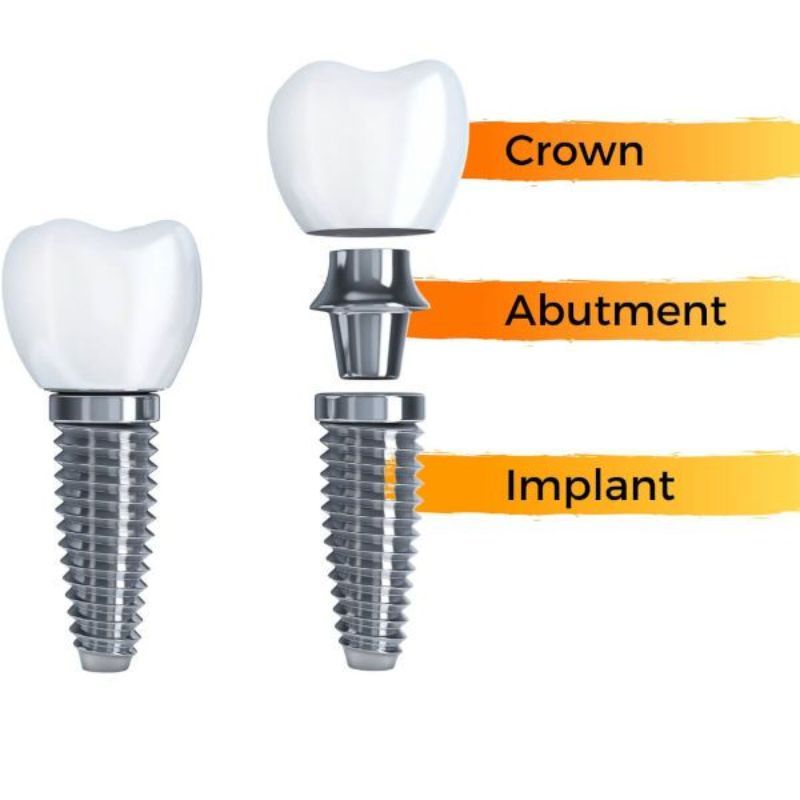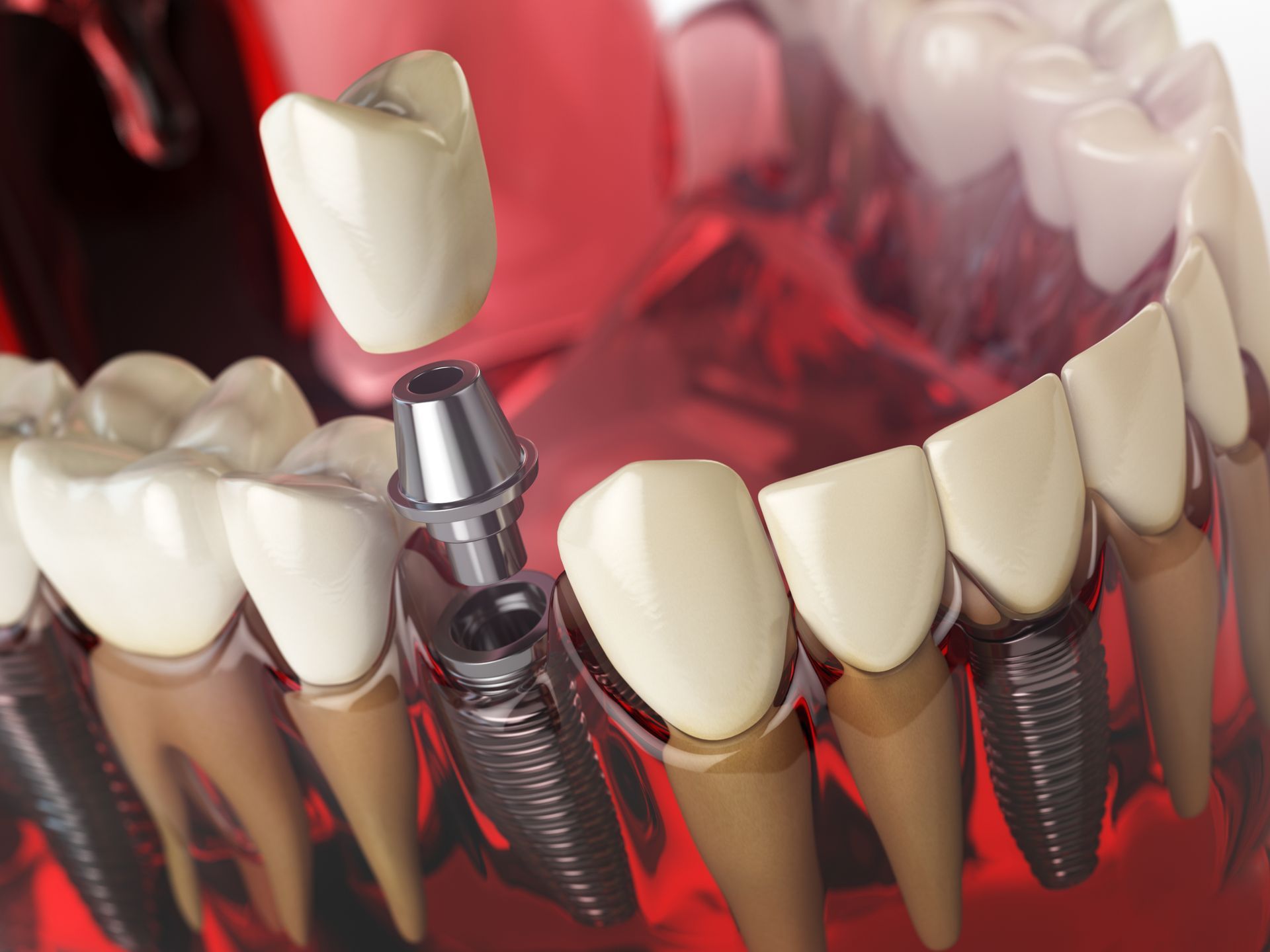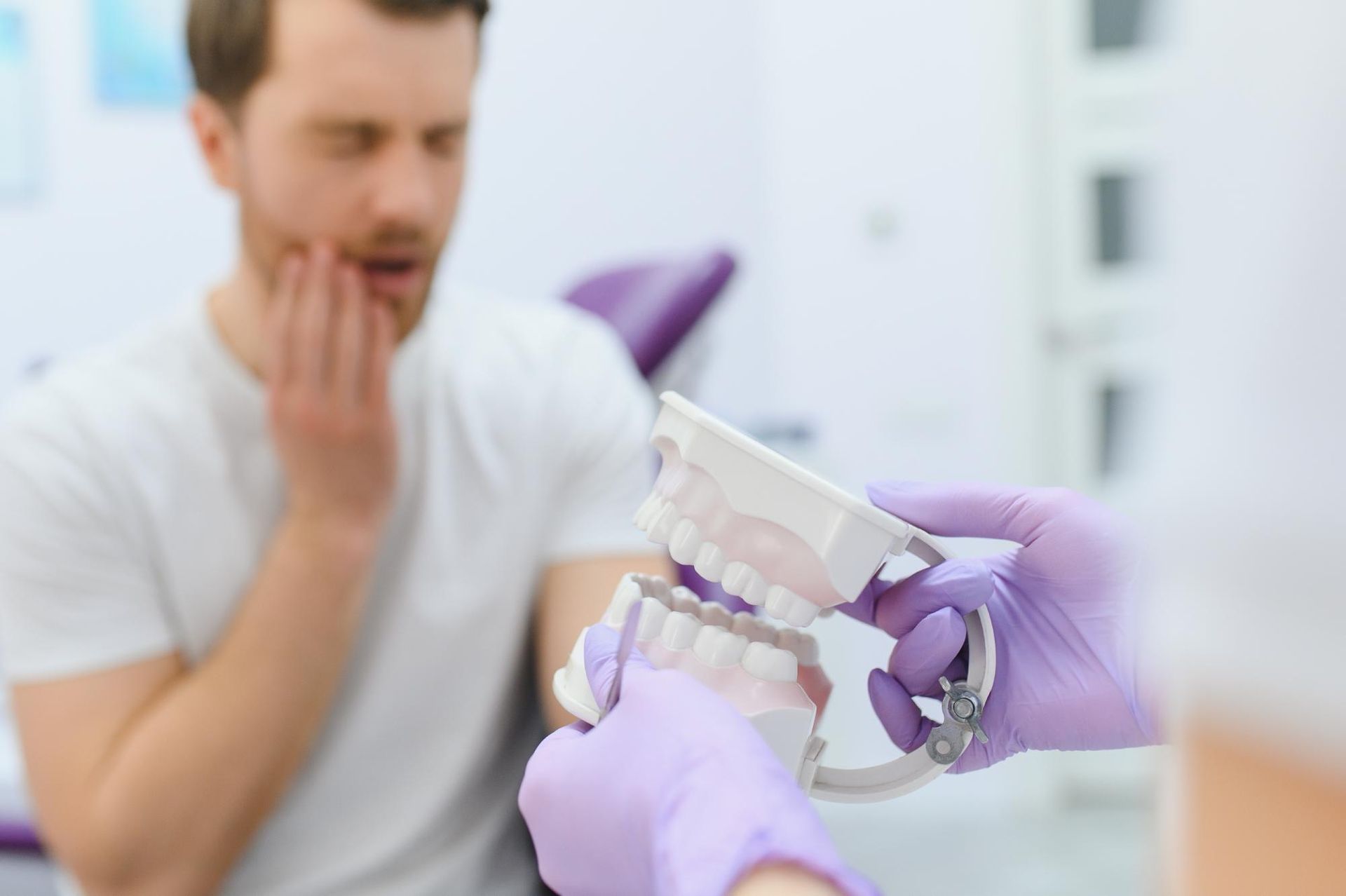15511 N Florida Ave, Tampa, FL 33613, United States of America
Top Benefits of Choosing Implant Crowns for Your Dental Restoration

16 Minute Read
Why are implant crowns a top choice for replacing missing teeth? Implant crowns offer a natural look and feel, providing a durable and stable solution. This article will explore their benefits and what you can expect from them.
Key Takeaways
- Implant crowns provide a stable and durable solution for tooth replacement, replacing both the visible part of a tooth and its root.
- Various materials, such as zirconia, porcelain-fused-to-metal, and Emax, are available for implant crowns, each offering different aesthetic and functional benefits.
- Proper care, including daily oral hygiene and regular dental checkups, is essential for the longevity and health of dental implant crowns.
What Are Implant Crowns?
Implant crowns are a marvel of modern restorative dentistry, designed to replace missing teeth and enhance the quality of life. These crowns are artificial teeth that are securely fixed to the jawbone, providing a stable and durable solution for tooth replacement. Unlike traditional dentures or bridges, dental implant crowns replace not only the visible part of a tooth but also its root, offering a comprehensive solution that mimics the function and appearance of natural teeth, including a missing tooth, while replacing missing teeth.
The primary purpose of dental implant crowns is to restore both the functionality and aesthetics of your smile. Dental implants prevent jawbone tissue loss, improve bite strength, and seamlessly blend with your existing teeth, enhancing your smile naturally. This holistic approach to tooth replacement ensures that patients can enjoy the benefits of a full, healthy smile without the drawbacks of conventional dental prosthetics.
Components of an Implant Crown

An implant crown consists of three essential components: the titanium post, the abutment, and the crown itself. The journey starts with the titanium post. This biocompatible metal is surgically inserted into the jawbone during the implant placement, serving to replace lost tooth roots. This post acts as a sturdy foundation, integrating with the bone over time to provide unparalleled stability and support.
Connecting the titanium post to the crown is the abutment, a small connector piece that ensures the crown stays firmly in place. The final piece of the puzzle is the crown, the visible part of the implant that is designed to look and function like a natural tooth. Together, these components create a robust and reliable tooth replacement that can withstand the daily demands of chewing and speaking.
How Implant Crowns Mimic Natural Teeth
The beauty of dental implant crowns lies in their ability to mimic the appearance and function of natural teeth. Solid zirconia crowns, for example, are highly valued for their aesthetics and durability, making them an excellent choice for achieving a natural look. These crowns are crafted to replicate the translucency and texture of natural tooth enamel, ensuring they blend seamlessly with your existing teeth.
Moreover, the design of implant crowns allows them to integrate fully with the jawbone, providing the same level of bite strength and stability as natural teeth. This meticulous attention to detail ensures that dental implant crowns not only look great but also perform effectively, restoring both your smile and your confidence.
Types of Implant Crowns
When it comes to dental implant crowns, there is no one-size-fits-all solution. Various materials are used to create these crowns, each offering unique benefits in terms of durability, aesthetics, and functionality. Understanding the different types of implant crowns can help you make an informed decision that best suits your needs and preferences.
From zirconia crowns known for their strength and aesthetic appeal to the versatile porcelain-fused-to-metal (PFM) crowns and the highly aesthetic Emax crowns, each type has its own set of advantages. Exploring these options helps you choose the right material for a beautiful and long-lasting smile.
Zirconia Crowns
Zirconia crowns are favored for dental implants because of their outstanding strength and ability to mimic the natural look of teeth.Made from a special ceramic material, these crowns can withstand significant chewing forces, making them ideal for the molar regions of the mouth where strength is paramount. Solid zirconia crowns offer the added benefit of reduced risk of allergic reactions, ensuring they are safe for a wide range of patients.
Veneered zirconia crowns offer translucency similar to natural tooth enamel while providing robust support, balancing strength and aesthetics. This combination makes zirconia crowns a versatile and reliable option for many dental restorations.
Porcelain-Fused-to-Metal (PFM) Crowns
Porcelain-fused-to-metal (PFM) crowns are another excellent choice for dental implants, combining the strength of a metal alloy base with the aesthetic appeal of a porcelain exterior. This combination ensures that PFM crowns are not only durable but also capable of mimicking the natural translucency of teeth, making them suitable for both front and back teeth.
The metal base provides the necessary support, while the porcelain overlay offers a lifelike appearance that blends seamlessly with your natural teeth.
Emax Crowns
Emax crowns are renowned for their superior aesthetic qualities, made from lithium disilicate glass-ceramic that closely resembles the natural look of teeth. While they are not as durable as zirconia crowns, Emax crowns offer excellent translucency and are a popular choice for front teeth where appearance is a top priority.
These dental crown strike a balance between beauty and function, providing a highly attractive option for those seeking a natural-looking dental restoration.
Cemented vs. Screw-Retained Implant Crowns
When attaching dental implant crowns, two primary methods are available: cemented crowns and screw-retained crowns. Each method has its own set of advantages and drawbacks, making the choice largely dependent on individual needs and circumstances. Understanding these differences can help you make an informed decision that best suits your dental restoration goals.
Factors such as aesthetics, functionality, and ease of maintenance play a crucial role in deciding between cemented and screw-retained implant crowns. While both methods aim to provide a stable and durable tooth replacement, the specific requirements of each patient can influence the choice.
Cemented Implant Crowns
Cemented implant crowns are attached to the abutment using dental cement, offering a seamless and aesthetically pleasing finish. Concealing abutment screw holes, cemented crowns offer a natural look that boosts confidence. However, this method also has potential drawbacks, such as the risk of inflammation if the dental cement seeps into the gums.
Moreover, cemented crowns can complicate maintenance and repairs, as they are more difficult to remove compared to screw-retained crowns. In cases where maintenance is required, a complete replacement of the crown may be necessary, adding to the complexity of care.
Screw-Retained Implant Crowns
Screw-retained implant crowns, on the other hand, are attached using screws that allow for easy removal and maintenance. This method simplifies repairs and replacements, as the crown can be easily unscrewed from the abutment. A screw retained implant crown is particularly useful in situations where access holes are not visible, such as in the back teeth.
However, screw-retained crowns may be less visually appealing due to the potential for chipping around the access hole. Additionally, these crowns can become loose over time, requiring periodic adjustments to maintain their stability. Despite these challenges, the ease of maintenance makes screw-retained crowns a practical choice for many patients.
Aesthetic and Functional Considerations
Selecting the right dental implant crown involves balancing aesthetic appeal with functional performance. Implant crowns are designed to resemble natural teeth, enhancing both the look and function of your smile. The choice of material is crucial to ensure that the crowns not only look good but also withstand the daily demands of chewing and speaking.
Materials like porcelain offer lifelike translucency and durability, making them a favorite for dental implants. Considering these factors helps patients achieve a dental restoration that enhances self-esteem and maintains oral health.
Achieving a Natural Look

Achieving a natural look with implant crowns is paramount for many patients. Materials such as zirconia and porcelain-fused-to-metal (PFM) play a significant role in this regard. Zirconia crowns, for instance, are known for their translucency, closely resembling the enamel of natural teeth. This quality allows them to blend seamlessly with the patient’s natural teeth, providing a more natural appearance.
Customization further enhances this lifelike look, as the materials can be tailored to match the shade and shape of the patient’s natural teeth. This attention to detail ensures that the implant crowns not only look natural but also feel like part of the patient’s original smile.
Ensuring Durability and Bite Strength
Durability and bite strength are critical considerations when selecting dental implant crowns. The material chosen must withstand the forces exerted during chewing while maintaining its structural integrity. Dental implant crowns are designed to be strong and resistant to wear, ensuring they can handle the daily demands of eating and speaking.
Ceramic crowns, for example, offer a balance of aesthetics and strength, making them a suitable choice for many patients. By considering factors such as the patient’s bite force and the specific placement of the implant, dentists can recommend the most appropriate material to ensure long-lasting functionality.
Caring for Your Implant Crowns
Proper care is essential to maintaining the health and longevity of dental implant crowns. Good oral hygiene practices, such as regular brushing and flossing, play a crucial role in preventing plaque buildup and gum disease. Neglecting these habits can lead to complications that could compromise the integrity of the implant crowns.
In addition to daily care, regular professional dental checkups are vital for ensuring the continued success of your dental restoration. Combining diligent at-home care with professional maintenance ensures implant crowns remain in excellent condition for years.
Daily Oral Hygiene Practices

Maintaining dental implant crowns requires a commitment to daily oral hygiene practices. Brushing at least twice a day and flossing daily are fundamental habits that help keep implant crowns clean and free of plaque. Non-abrasive toothpaste is recommended to protect the crowns’ surface.
Oral irrigators can further reduce plaque buildup and inflammation when used regularly. Water flossers, in particular, are beneficial for cleaning under implant crowns and should be used at least twice a week. These tools, along with interproximal brushes, ensure thorough cleaning and help maintain the health of your implant crowns.
Professional Dental Checkups
Regular dental checkups are crucial for maintaining the cleanliness and health of implant crowns. Patients with dental implant crowns should see their dentist for professional cleanings at least twice a year. Routine visits are important for maintaining dental health. These visits allow the dentist to remove any plaque or tartar buildup that may not be addressed through daily oral hygiene practices.
Consistent professional cleanings and regular dental visits are crucial to preventing gum disease and ensuring the longevity of implant crowns. By adhering to a routine schedule of dental checkups, patients can catch potential issues early and maintain the overall health of their dental restorations.
Summary
In summary, dental implant crowns offer a robust and aesthetically pleasing solution for replacing missing teeth. By understanding the different types of implant crowns, their components, and the methods of attachment, patients can make informed decisions tailored to their specific needs. The choice between cemented and screw-retained crowns depends on factors such as aesthetics, functionality, and ease of maintenance, each offering distinct advantages and considerations.
Caring for implant crowns through diligent daily oral hygiene and regular professional checkups is essential to ensure their longevity and optimal performance. With the right care, dental implant crowns can provide a natural look and strong bite force, enhancing both your smile and your confidence for years to come. Embrace the benefits of dental implant crowns and enjoy a healthier, more radiant smile.
FAQ
Frequently Asked Questions About Implant Crowns
-
What is an implant crown?
An implant crown is an artificial tooth that is secured to a titanium post, replacing a natural tooth after its removal. It serves as a long-term solution for restoring function and aesthetics in dental care.
-
What is the best crown for implants?
The best crown for implants largely depends on the intended use; for aesthetic appeal, all-porcelain crowns are recommended, while full metal crowns are preferable for durability under heavy chewing. Make your choice based on whether appearance or strength is your priority.
-
Are implant crowns more expensive?
Yes, implant crowns are generally more expensive than traditional crowns or bridges due to the need for multiple visits and the potential lack of insurance coverage for implants.
-
What materials are used for implant crowns?
Implant crowns are typically made from materials such as zirconia, porcelain-fused-to-metal, Emax, gold, acrylic, and composite resin. Each material offers different aesthetic and functional benefits, allowing for tailored solutions based on individual patient needs.
-
How do screw-retained crowns differ from cemented crowns?
Screw-retained crowns facilitate easy removal for maintenance, whereas cemented crowns provide better aesthetics but are more challenging to remove when needed. Ultimately, the choice depends on priorities like aesthetics versus accessibility.



CONTACT TAMPA'S DENTAL IMPLANT EXPERTS
Get The Smile You've Been Dreaming of Today
We offer affordable financing options for all your implant needs, get started with us today by claiming your Free Implant Consult Package!

Other Ways to Contact Us
Get Your Free Dental
Implant Consult Package
Get your First Consultation, Panoramic X-Rays, & Treatment Plan with our head dentist for FREE to see if you qualify for implant treatment. Everything you need to get started transforming your smile. $397 Value. Please note, dental implants are NOT covered by Medicare or Medicaid.
Reserve Your Spot Today - Limited Availability Every Month

Dental Implants
Quick Links
Contact Information
tampadentalimplants@gmail.com
15511 N Florida Ave, Tampa, FL 33613, United States of America
All Rights Reserved | Tampa Dental Implants









